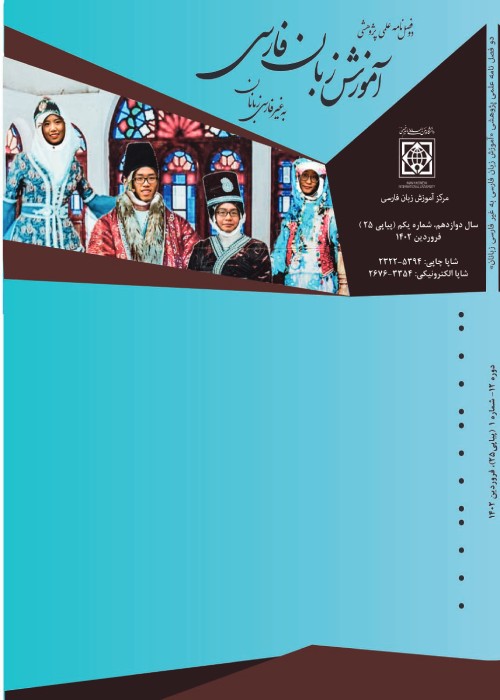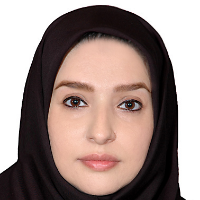The Development of Writing Skill in 13-18 Years Old Persian Speakers:Pause and Syntax Patterns
Author(s):
Article Type:
Research/Original Article (دارای رتبه معتبر)
Abstract:
Writing skill refers to communication through a system of written signs. One of the major issues in language teaching relates to exploring the differences in the development of this skill. The present study aimed to examine the development of writing skill in terms of pause and syntax patterns. To collect the required data, 30 high school students were randomly selected (15 females and 15 males). The students were asked to write a paragraph about cheating on exams and the ways to prevent it. To prevent interference and distortion of the results, the participants were homogenized in terms of age, gender, number of group members, level of familiarity with computers and word processing software, and also grade point averages. Then, they were randomly assigned to three groups based on age. The results indicated that 13 to 18-year-old Persian speakers were different with regards to the duration of writing, number of words used in writing, the duration of pauses, pause patterns, syntactic location of pause occurrence, and text editing while writing a text. With increasing age, these differences became more prominent.
Extended Abstract
Literature Review
Hasanlou and Mohammadi (1388) assert that writing is one of the most complex tasks for language learners to master. In their research, they found that those who were better writers were also better speakers and that age and level of education play a vital role in the mastery of written skill. According to Deane, Odendahl, Quinlan, Fowles, Welsh, and Bivens (2008), the way an individual writes, mirrors their understanding and recognition of vocabulary meaning and syntactic structures; overall competence; power to relay information and relate to environmental phenomena; and generally, overall cognitive development. One important variable to study during writing is pause. How long a person pauses when writing can be affected by various factors such as age, gender, level of education, cognitive growth, etc. Myhill (2009) believes that with the advancement of age, syntactic complexities are more observable in writing. Also, sentence length and frequency of clauses and variation in clauses tend to increase with older writers. Schilperoord (2002) is among the various scholars who have conducted extensive research in the field of pauses during writing and he believes that this important factor has not received its due attention in English. The number of studies conducted on pauses during writing in Persian is almost non-existing and to the best of the writers’ knowledge, this is one of the pioneering studies in this filed. Johanson (2009) found that the development of writing skill is age dependent and that the overall quality of the written texts by 10-18 years olds was completely different.
Conclusion and
Extended Abstract
Introduction
Writing skill means communication through a system of written signs. This skill, as well as the differences in its growth rate, is among the major issues in language and language learning studies. In fact, communicating through written language is not only a great hurdle for second/foreign language learners, but also native speakers tend to display difficulty in this area. Fromkin, Rodman and Hymes (2002) have compared speaking with writing as two major production skills and have concluded that while both skills are vital in language learning, speaking has received a great deal of research attention while writing has not received its limelight. While speaking uses various vocal signals to convey a message, writing has to use sets of arbitrary symbols to achieve the same effect and in turn is more difficult to conduct. The present study aimed to examine the development of writing skill in high school Persian native speakers in the context of pauses and pause patterns as a cognitive factor.Literature Review
Hasanlou and Mohammadi (1388) assert that writing is one of the most complex tasks for language learners to master. In their research, they found that those who were better writers were also better speakers and that age and level of education play a vital role in the mastery of written skill. According to Deane, Odendahl, Quinlan, Fowles, Welsh, and Bivens (2008), the way an individual writes, mirrors their understanding and recognition of vocabulary meaning and syntactic structures; overall competence; power to relay information and relate to environmental phenomena; and generally, overall cognitive development. One important variable to study during writing is pause. How long a person pauses when writing can be affected by various factors such as age, gender, level of education, cognitive growth, etc. Myhill (2009) believes that with the advancement of age, syntactic complexities are more observable in writing. Also, sentence length and frequency of clauses and variation in clauses tend to increase with older writers. Schilperoord (2002) is among the various scholars who have conducted extensive research in the field of pauses during writing and he believes that this important factor has not received its due attention in English. The number of studies conducted on pauses during writing in Persian is almost non-existing and to the best of the writers’ knowledge, this is one of the pioneering studies in this filed. Johanson (2009) found that the development of writing skill is age dependent and that the overall quality of the written texts by 10-18 years olds was completely different.
Methodology
To collect the required data, 30 high school students were randomly selected; among them 15 females and 15 males, respectively. It should be noted that all the participants were fluent in Persian and also had enough mastery in writing. The students were asked to write a paragraph about students' cheating issue and preventive methods in high schools. To prevent interference and distortion of the results, the participants were balanced in terms of age, gender, level of familiarity with computers and word processor software and also school grade point averages. Then they were randomly divided into three groups based on age.
Results
The results indicated that 13 to 18-year-old Persian speakers are different with regards to the duration of writing, number of words used in writing, the duration of pauses, pause patterns and place of pause occurrence as well as text editing while writing a text. In the 13-14 year old group (first group), the average time span for writing was 1671 seconds, average pause duration 936 seconds and the average number of words used was 15. In the second group (15-16 year olds), the average time span for writing was 1800 seconds, average pause duration 973 seconds and the average number of words used was 227. Finally for the last group (17-18 year olds), the average time span for writing was 2413 seconds, average pause duration 1057 seconds and the average number of words used was 331. The t-test results indicate that there is a significant difference between the first (13-14 year olds) and third (17-18 year olds) groups as regards to the average time span for writing, average pause duration and the average number of words used. No significant difference was seen between the first and second groups. The results also indicate that the first group made 460, second group 697, and the third group 1530 corrections on the texts respectively. The t-test results reveal a significant difference among all three groups. The t-test results reveal no significant difference between pause duration and correction pauses between the second and third group; however, a significant difference was observed between the first and third group.Conclusion and
Discussion
Based on the obtained results, the following conclusions can be made: 1. older participants took longer to write their texts 2. the pause duration increased with age. 3. the number of words per text increased with age. 4. with the advancement of age, the number of overall used characters and edited characters increased. 5. at the word level, with the advancement of age, the number and duration of pauses decreased; however, the results were vice versa which revealed an increase at the sentence and clause levelKeywords:
Language:
Persian
Published:
Journal of Teaching Persian to Speakers of Other Languages, Volume:7 Issue: 15, 2018
Pages:
119 to 136
magiran.com/p1906920
دانلود و مطالعه متن این مقاله با یکی از روشهای زیر امکان پذیر است:
اشتراک شخصی
با عضویت و پرداخت آنلاین حق اشتراک یکساله به مبلغ 1,390,000ريال میتوانید 70 عنوان مطلب دانلود کنید!
اشتراک سازمانی
به کتابخانه دانشگاه یا محل کار خود پیشنهاد کنید تا اشتراک سازمانی این پایگاه را برای دسترسی نامحدود همه کاربران به متن مطالب تهیه نمایند!
توجه!
- حق عضویت دریافتی صرف حمایت از نشریات عضو و نگهداری، تکمیل و توسعه مگیران میشود.
- پرداخت حق اشتراک و دانلود مقالات اجازه بازنشر آن در سایر رسانههای چاپی و دیجیتال را به کاربر نمیدهد.
دسترسی سراسری کاربران دانشگاه پیام نور!
اعضای هیئت علمی و دانشجویان دانشگاه پیام نور در سراسر کشور، در صورت ثبت نام با ایمیل دانشگاهی، تا پایان فروردین ماه 1403 به مقالات سایت دسترسی خواهند داشت!
In order to view content subscription is required
Personal subscription
Subscribe magiran.com for 70 € euros via PayPal and download 70 articles during a year.
Organization subscription
Please contact us to subscribe your university or library for unlimited access!



